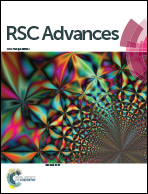Mechanistic investigation on radical-induced construction of oxindoles: radical versus electrophilic cyclization†
Abstract
This work is based on our previous reported experimental results (RSC Advances, 2016, 6, 27000). The mechanism of constructing oxindoles via tandem radical reaction of N-arylacrylamide with tertiary cycloalkanols is theoretically explored by using density functional theory (DFT). A four-step mechanism was put forward for the reaction. Step 1 is related with the ring-opening process of cycloalkanol radical after the oxidation, step 2 corresponds to the intermolecular attack between keto-included alkyl radical and N-methyl-N-phenylmethacrylamide, step 3 is associated with the intramolecular C–C bond formation via the cationic attack, and step 4 is the deprotonation towards the final product. It is found that step 2 is the rate-limiting step. Importantly, step 3 is updated to be a cationic step (channel 2), instead of the previously suggested radical step (channel 1). After the ring-opening processes, comparative study indicates that the intramolecular reactions of β-, γ-, and δ-keto radicals determines the product selectivity. The low selectivity of product in the cyclopentanol-involved reaction would originate from the high competition between intra- and intermolecular reactions, which is in agreement with our previous experimental observations.



 Please wait while we load your content...
Please wait while we load your content...